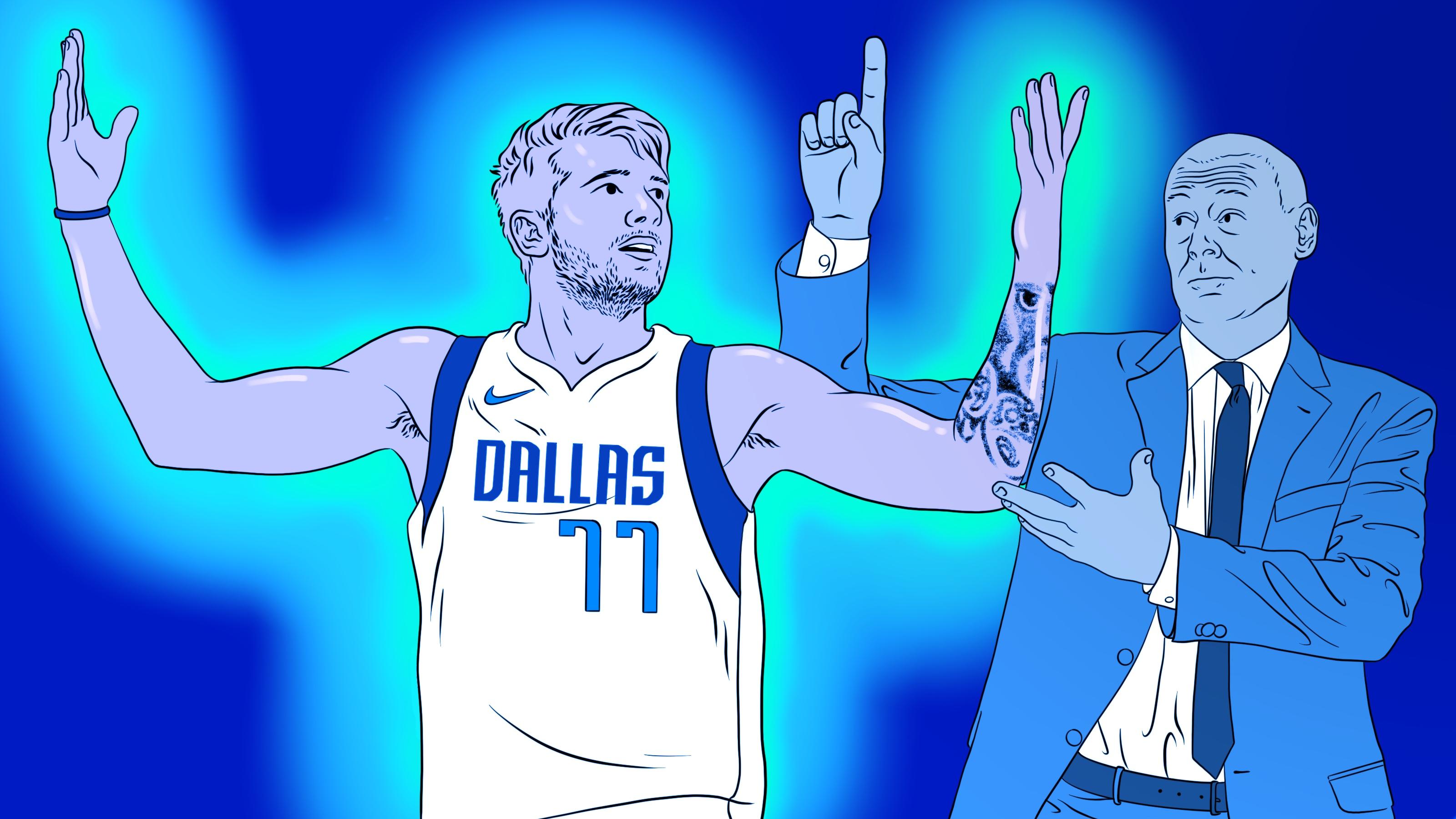
Luka Doncic is having a moment. The 20-year-old has turned himself into an MVP candidate in just his second season in the NBA, leading the Mavs to a tie for fourth place in the West and the best offensive rating (116.0) in league history. Dallas is coming off its most impressive win of the season: a 114-100 road victory Sunday over a Lakers team that had won its previous 10 games. Luka helped close the game on a play dripping with symbolism, burying a stepback 27-footer over LeBron James:
It was only a few weeks ago that the Mavs were scuffling at 6-5, with two losses to the lowly Knicks. The team has changed but Doncic hasn’t. He has been the same player the whole time. The big difference has been that Dallas coach Rick Carlisle has tweaked his rotation to maximize his young star’s strengths. Carlisle needed time to figure out his team, as well as how to best use Kristaps Porzingis, who hadn’t played in an NBA game since tearing his ACL in February 2018 with the Knicks. Carlisle’s biggest strength is his ability to find the best roles for his players. Now, for the first time in almost a decade, he can use that skill on a relevant team.
Everything in Dallas revolves around Luka’s ability to dominate the ball. He leads the league in touches, at 98.8 per game. LeBron and Nikola Jokic are the only other players this season at more than 91. And Luka’s average amount of time with the ball per game (9.2 minutes) is almost as much as LeBron and Jokic combined (10.8). No NBA player has touched the ball as much as Luka in the past six seasons. It’s not an easy style for the players orbiting him to get used to. He sucks up all the oxygen on offense. A player averaging a near triple-double (30.2 points, 9.9 rebounds, and 9.6 assists per game) doesn’t leave many points, rebounds, or assists for everyone else.
Carlisle has adjusted his rotation accordingly so that the players who don’t need the ball play more with Luka. After using eight different starting lineups in the first 13 games, Carlisle has settled on the same unit over the last six: Doncic, Porzingis, Dwight Powell, Dorian Finney-Smith, and Tim Hardaway Jr. That group has an eye-popping net rating of plus-24.3 in 88 minutes, the best among all lineups in the NBA that have played at least 80 minutes this season.
Everyone fits perfectly into their role. Luka is the ball handler in the two-man game and Powell is the roll man, while Porzingis, Finney-Smith, and Hardaway space the floor around them. Doncic is a wizard when coming off ball screens: He scores at an incredibly high rate (94th percentile among ball handlers) on many attempts (40.8 percent of his offensive possessions). Powell is an elite finisher who was in the 90th percentile or higher among roll men in the league in each of the last two seasons. And Porzingis and Hardaway lead the Mavs in catch-and-shoot 3s this season, while Finney-Smith ranks fourth:
Mavs Catch-and-Shoot 3s Leaders
The sheer amount of size from this five-man unit is difficult to defend. Hardaway, at 6-foot-5 and 205 pounds, is the smallest player on the floor. Doncic, at 6-foot-7 and 230 pounds, can pass over traps, while his teammates are so tall that closeouts from shorter guards don’t bother them.
That size is just as important on the other side of the ball. The Mavs can shrink the court, extending out on the perimeter and shuttling offensive players into the outstretched arms of Porzingis, who is sixth in the NBA in blocks per game (2.1). Finney-Smith is their perimeter stopper, a 6-foot-7 wing who has carved out a role for himself as a 3-and-D player in his fourth season.
The biggest revelation has been Hardaway, a 27-year-old known mostly for a bloated, four-year, $71 million contract. He’s a gunner who had been miscast as a primary option, whether he was a starter in New York or a sixth man in Dallas. His ability to get up shots quickly makes more sense now that he has bought into a secondary role playing off Luka. Hardaway is always ready to shoot; he doesn’t need to dribble to get into rhythm. He’s third on the team in field goal attempts (10.2 per game) despite averaging his lowest number of touches (33.1) since he was a reserve in Atlanta in 2015-16.
Changing his offensive role has also made him a better defender. Hardaway has never been known for his defense, but he has the physical tools to hold his own. He’s in the 75th percentile of defenders against ball handlers on the pick-and-roll this season despite having to match up with players like Devin Booker, James Harden, and Paul George. Look at the way he moves his feet and stays connected to his man in these clips:
The other thing that Carlisle has seemed to figure out is that Porzingis doesn’t really need the ball. The coach staggered his two young stars’ playing time for the first month so that both could have the offense run through them. But Porzingis struggled without Doncic next to him. He’s still trying to regain his timing on the court, and he tends to settle for contested jumpers when trying to create. Every European 7-footer with a jumper gets compared to Dirk Nowitzki (much less one in Dallas), but that’s like comparing every 6-foot-3 guard who shoots 3s to Steph Curry. Porzingis probably can’t make a living on the same types of shots that Dirk mastered. He’s shooting 43.5 percent from 2-point range on 8.9 attempts per game, which puts him in a tie for no. 71 in 2-point percentage among the 78 players in the NBA this season taking at least 8.0 per game.
It’s easier for Dallas to live with such inefficient offense from Porzingis when he’s also spacing the floor for Luka to get to the rim. He has played only 19 minutes without his European costar in his last eight games, after playing 64 minutes without him in his first 10.
Keeping Luka and Porzingis together has also created more opportunities for the Mavs reserves to play with the ball. Dallas has a trio of talented combo guards—Delon Wright, Seth Curry, and Jalen Brunson—who were being underused next to two high-usage stars. Now they have the freedom to run pick-and-rolls in space without having to defer to anyone else. The Mavs’ roster doesn’t have a lot of big names outside of their top two, but it is full of well-rounded offensive players who can pass, shoot, and drive. Dallas spaces the floor so well that it’s easy for it to exploit any weak spots in the opposing defense.
Their all-bench lineups have been killing opposing second units during their recent hot streak. Wright, Curry, Maxi Kleber, and Justin Jackson all have net ratings higher than plus-10 over the last eight games, while the Mavs are plus-5.6 in 120 minutes without Doncic during that span. They have one of the best players in the NBA and one of the best benches behind him, which puts a lot of pressure on opponents throughout a game. Dallas can create a lead at any point and has the manpower to hold on to it.
The magic of Carlisle is how he structured his rotation to maximize his players. He finds ways to get the most out of what he’s given:
Playing Time With Luka
All that said, the Mavs still have plenty of flaws, many of which were exposed in their 114-99 loss to the Clippers last week. It starts on defense. While Finney-Smith (220 pounds) and Hardaway (205) have tried their best, they just don’t have the bulk to hang with supersized wings like LeBron and Kawhi. Dallas has the NBA’s no. 15 defense, which is impressive considering some of the limitations on its roster, but it still has plenty of holes that can be exploited in the playoffs.
But the Mavs’ biggest issue might be their reliance on their young MVP candidate. There’s a blessing and a curse that comes with a ball-dominant perimeter player. A team that relies on one player to do everything doesn’t have a Plan B when he can’t. There are more than a few similarities between Doncic and James Harden, and Harden’s teams have always fallen short in the postseason because they haven’t had a second star who could take some of the pressure off him.
The Clippers overloaded their defense on Luka and hounded him all over the floor, holding him to 4-of-14 shooting with seven turnovers. And because so much of Porzingis’s and Hardaway’s offense comes from playing off him, the two combined to score only 23 points on 7-of-21 shooting.
Doncic could go on to win multiple MVPs over his career. But there’s also a reason the league’s MVP has won an NBA title only five times since the turn of the millennium. The award usually goes to the star player on an elite team with the least amount of help, a formula that works better in the regular season than the playoffs.
It’s hard for anyone to thrive next to this version of Luka in offensive roles beyond catching lobs and spotting up. But try convincing a 20-year-old with his talent that he can’t do everything. That’s something that can only be learned with time. Carlisle can say all the right things, but Luka still has to be willing to listen. Dallas has already exceeded expectations given the youth of its best players. The team has the depth and the coaching to get Doncic into the playoffs. It will be on him to learn the right lessons once he does.
Statistics are current through Monday morning.

